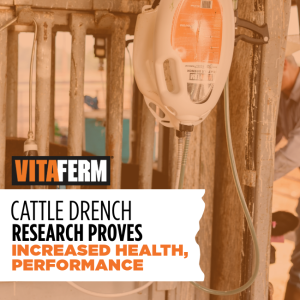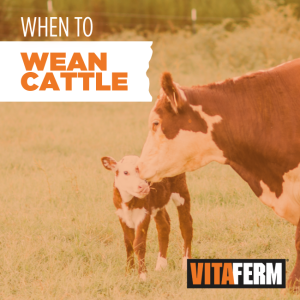Freshly weaned calves are a lot like small children starting their first day of preschool. They’re learning a new routine in a different environment and eating from a new menu all while being without their mamas for the first time. That equals a lot of stress, which can lead to sickness, going off feed and water and overall loss of performance.
But just like those small children, newly weaned calves can thrive in their new environment if producers take a proactive approach prior to weaning or receiving calves. They need to consider the pen layout, provide adequate water, and feed a balanced diet fortified with the nutrients the calves require to stay healthy and grow.
Feeding Fundamentals
For a calf that has predominantly survived on three nutrition sources during its lifetime – milk, grass and water – being taken away from two of those and moved to a dry lot for any amount of time can be rather alarming. Make the transition to a weaned-calf diet as smooth as possible by introducing familiar feedstuffs first.
“On day one, you need to consider what you are going to feed the calves. You want to do the best you can to minimize new and unusual feed, like silage,” said Kevin Glaubius, Director of Nutrition for BioZyme® Inc. “You are better off to use long-stem grass hay for 2-3 days and then transition them to silage.”
Putting the grass hay in the bunks will help teach the calves to come to the bunks for their feed. It will also be more similar to the forages they have been grazing in the pasture. Putting something out with an unfamiliar aroma, taste and texture, like silage, will likely deter the calves from going to the bunks, thus not finding the source of their nutrition. Once the calves have found the hay, start adding silage or whatever you choose to feed to the hay and transition their diet gradually.
If your calves are accustomed to eating creep feed or grain, you might be able to start them on a more concentrated diet more quickly. Remember that protein has been an important part of their diet, as milk is about 20% protein. The impact of stress will cause calves to eat about one-third of what they need, so consider keeping a high-protein diet for the first few weeks they are on feed, then move their protein down to 13-14%.
Set-up for Success
One way to make sure that calves find feed bunks and water sources is to plan your pen arrangement. Calves are notorious for circling the perimeter of the fence bawling, looking for their mothers or for a way out, so make sure you have bunks, waterers and mineral placed accordingly.
Glaubius recommends placing your bunk perpendicular to one of the outer fences to form a “T” so when they are circling the fence, they eventually will run into the bunk. It is also wise to have a mineral source – tub or feeder – about 6 to 8 feet out from the fence, so the calves will also “stumble” into the mineral, sniff at it and hopefully get some nutrition.
Since water is so important to both the health of the animal and promoting feed intake, making sure a fresh, clean accessible water supply is vital. If you are in an environment where you have a ball in your tank to prevent it from freezing, that fresh-weaned calf might not understand how to push the ball down to get water. If you can, remove the ball so the calf can readily see and hear the water. You don’t want your water source to be too loud, but the sound of running water will draw calves to it.
Invest in Health
“Your ultimate goal with new calves should be to get them into a pen, get them eating and drinking. They will still have stress, but don’t compound it with nutritional stress,” Glaubius said.
One of the best ways to make sure your calves get off to the best start possible is to with a three-step approach from VitaFerm®. Within 48 hours of receiving or post-weaning, give your calves an initial does of Vita Charge® Cattle Drench to support digestive health and promote feed and water intake. Vita Charge Drench will jump start feed and energy intake while stimulating the immune system. It also allows maximum effectiveness of vaccinations.
Next, provide your calves with Vita Charge Stress Tubs to help them level out consumption. Glaubius recommends one 50-pound Stress Tub per 15 head of calves and suggests keeping them out for 14-21 days. Vita Charge Stress Tubs are also available with HEAT® to help combat heat stress anytime the temperature is 70-degrees and hotter.
“The Stress Tubs are important to get them eating, and I would place them around the perimeter of the pen so the calves will find them easily. The Stress Tubs with HEAT are great for late summer and early fall and help reduce another layer of stress,” Glaubius said.
Finally, choose the VitaFerm Gain Smart® mineral that is right for your situation. Gain Smart is a line of vitamin and mineral supplements with the Amaferm® advantage that promotes economically produced pounds by maximizing the natural energy and protein available in forage. VitaFerm and VitaFerm Gain Smart are recognized by Superior Livestock Auctions as the first and only nutrition programs in their line of value-added programs. Gain Smart Stocker is ideal for calves going onto grass, while Gain Smart Wheat is designed to balance basic nutrient needs for maximized efficient gain on wheat or small grain pasture. Gain Smart Balancer RU1600 is designed for cattle being fed a grain diet.
For those producers who are leery of investing in their calves early on, Glaubius reminds that it should be the goal to keep calves healthy and reduce as much stress as possible prior to the time they reach the feedlot phase.
“It is better to spend money up front and save money at the back end of your program. Get them off to a healthy start because right now gain shouldn’t be as big of a priority as keeping them healthy. Money spent at the beginning is money spent wisely,” he said.
Planning a good health and nutrition program will get your calves off to the best start possible. Preparing for changes helps reduce stress and increase performance.



